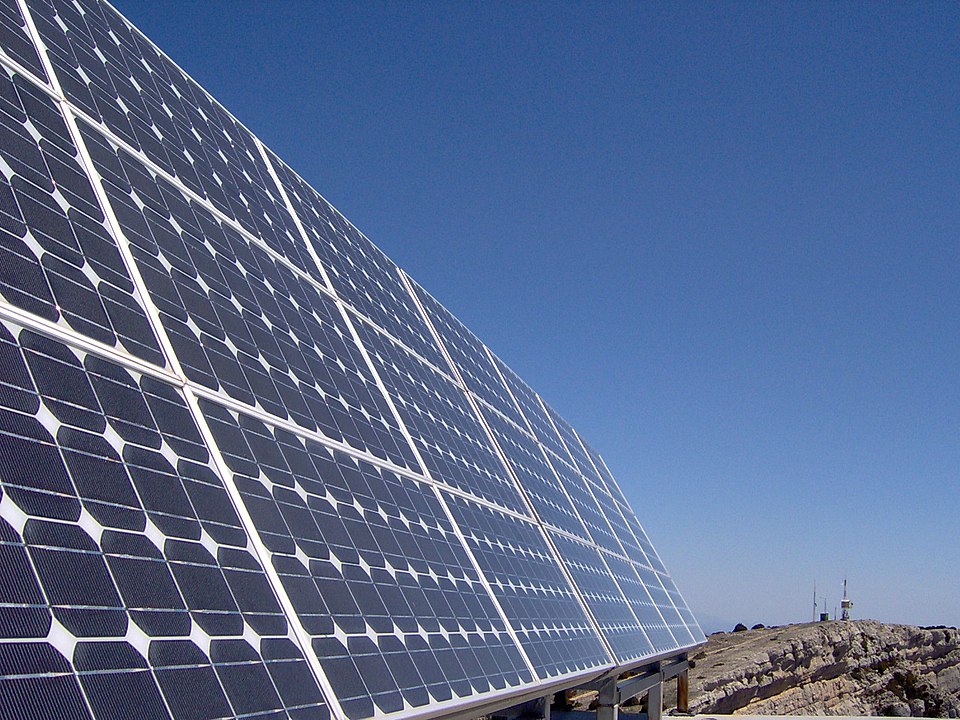Extraordinary progress in durability and solar energy conversion with perovskites
16.09.2025
 |
|
Solar panels and repeater in the background. Image: Fernando Tomás (CC 2.0). |
- Researchers at IMDEA Nanociencia have developed a perovskite solar cell with a certified efficiency of 25.2%, very close to the world record of 26.7%.
- In addition, they managed to manufacture a 5 cm square solar panel with this material that maintains high efficiency (22.1%) and shows extraordinary stability.
| Tweet |
Madrid, September 16th, 2025. Perovskite solar cells are one of the most promising technologies for generating clean, cheap energy, as they can achieve efficiencies similar to those of silicon but at a lower cost. However, their commercial application is still limited by long-term stability issues. Now, an international collaboration led by IMDEA Nanociencia has achieved an extraordinary result, close to the world record, in the efficiency of perovskite solar cells. Researchers have developed new materials that significantly improve both the efficiency and durability of these solar cells, bringing them one step closer to market.
The breakthrough focuses on designing molecules for hole transport—an essential component of solar cells—from a family of compounds called spiro-phenothiazines. In particular, the variant called PTZ-Fl has shown extraordinary performance: solar cells incorporating it achieve an efficiency of 25.8% (25.2% NRL certified) and maintain up to 80% of their performance after more than 1,000 hours of continuous operation under standard test conditions. In addition, the team managed to manufacture a 25 cm² module with an efficiency of 22.1%, an exceptional result given that efficiency tends to decrease considerably in larger panels.
Another key aspect is stability. Devices developed with this new material have been shown to withstand more than 1,100 hours of operation under illumination without degrading, and to retain 95% of their efficiency after 3,600 hours under demanding conditions (ISOS-D-1 protocol). These extraordinary results make this material a potential candidate for applications and open the door to the manufacture of reliable, low-cost, large-scale perovskite solar panels.
Professor Nazario Martín, leader of the research, explains: "These new materials are very attractive for commercialisation, as they offer much higher performance than commercial silicon solar cells, which barely reach 18% efficiency. Perovskites also allow their chemical properties to be modified in a versatile way, which opens up a range of possibilities for complementing silicon and building the next generation of solar panels."
This work has recently been published in the journal Advanced Materials. It is the result of a collaboration between researchers at the Madrid Institute for Advanced Studies in Nanoscience (IMDEA), the Complutense University of Madrid, the Swiss Federal Institute of Technology in Lausanne (EPFL), Sungkyunkwan University, the Korea Institute of Energy Research and Pusan National University (South Korea); and has been partially funded by the Severo Ochoa Excellence accreditation to IMDEA Nanociencia (CEX2020-001039-S).
Glossary:
- Perovskite: Perovskite refers to both the mineral calcium titanate (CaTiO3) and its crystalline structure, known as the perovskite structure. The general chemical formula for perovskite compounds is ABX3, where “A” and “B” are two cations of very different sizes and “X” is an anion (halide) bonded to both.
- Perovskite solar cell: a type of solar cell that contains a compound with a perovskite-type structure as an active layer that absorbs sunlight. High tolerance to defects allows the design of perovskites with varying bandgaps, facilitating the manufacture of materials that can absorb across a wide range of the spectrum, enabling superior photovoltaic conversion efficiency. These perovskites allow high efficiency to be achieved using very thin layers, which is why perovskite solar cells can be flexible, semi-transparent and lightweight. They are also cheaper and faster to produce than any other type of cell, as they can be manufactured using solution processes. Finally, they have a very high material recovery and recycling rate, which reduces manufacturing costs.
- Photovoltaic conversion efficiency: this is the percentage of sunlight that a solar cell can convert into useful electricity. The average for current commercial panels is around 18%
Reference:
J. Urieta-Mora, S. J. Choi, J. Jeong, et al. Spiro-Phenothiazine Hole-Transporting Materials: Unlocking Stability and Scalability in Perovskite Solar Cells. Adv. Mater. (2025): e05475. DOI: 10.1002/adma.202505475
![]() Link to IMDEA Nanociencia Repository: https://hdl.handle.net/20.500.12614/4064
Link to IMDEA Nanociencia Repository: https://hdl.handle.net/20.500.12614/4064
Contact:
Prof. Nazario Martín
Group of Nanocarbons and Organic Photovoltaics
https://nanociencia.imdea.org/nanocarbons-and-organic-photovoltaics/group-home
IMDEA Nanociencia Dissemination and Communication Office
divulgacion.nanociencia [at]imdea.org![]()
![]()
![]()
![]()
![]()
Source: IMDEA Nanociencia.
IMDEA Nanociencia Institute is a young interdisciplinary research Centre in Madrid (Spain) dedicated to the exploration of nanoscience and the development of applications of nanotechnology in connection with innovative industries.




